Did you know that the average recruiter spends 5 to 20 seconds reviewing one resume, and the average number of applicants for one position is as high as 250?
Also, trends in resume design and content change over the years, so it is not uncommon for people to use outdated design templates that are uninformative, overloaded with text and redundant information (e.g. Europass and the like). An informative and at the same time concise CV is extremely important when changing professions and in order to start a career in the IT field. So, your CV must be such that all information is clear, understandable at first glance and focused on the position you are seeking. In this post, we want to show you what a good, modern resume looks like, what are the most important aspects of creating a CV to attract the attention of a potential employer and get an invitation to a job interview.
First, we share an example of a good CV, and then we will comment on it.
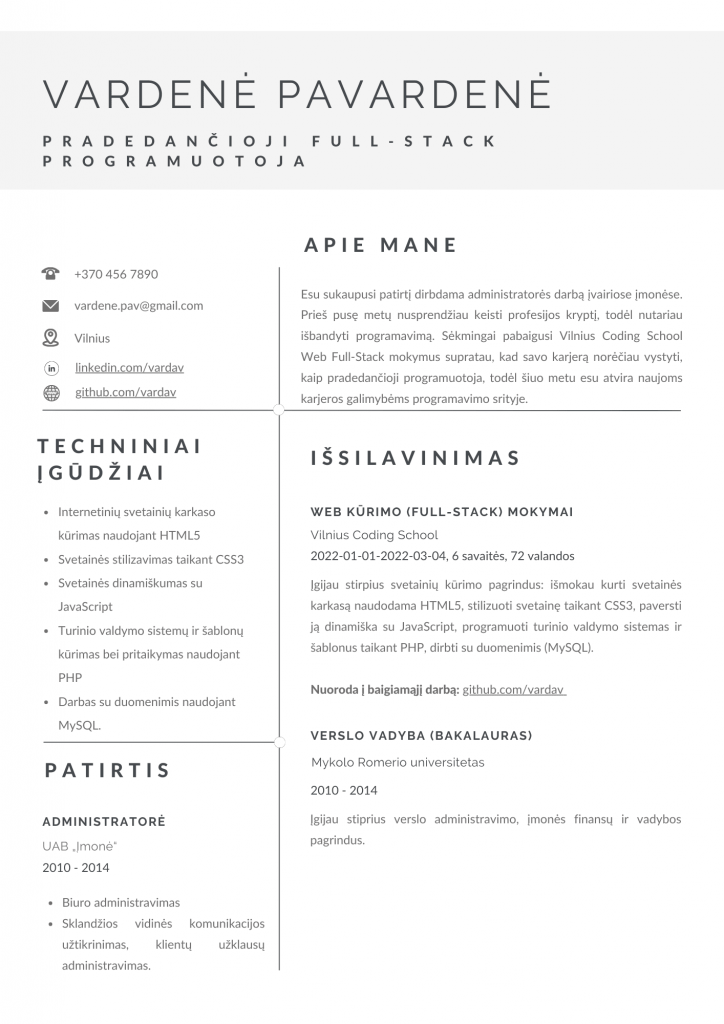
You can easily create a CV of this or a similar design using specially designed platforms. This resume was created using www.canva.com. When creating a CV for IT job seekers, you can choose from a variety of color combinations, but it is important that they are not "eye-catching" and that the fonts are neutral and the text is easy to read. A CV written in "children's" letters will certainly not look right and may cause difficulty in reading it.
As you can see in the example, it is best when the text is arranged in clear blocks so that all essential information can be seen at a glance. But that alone is not enough. In order for a CV to be truly clear, a certain layout is required. We will discuss it further.
One of the most important aspects is to clearly name the position you are applying for, for example, "Beginner Full-stack Developer", "Beginner Data Analyst", "Beginner C# Programmer", "Beginner Manual Tester", etc. It is very important to define one position, we do not recommend specifying several positions you are interested in, for example "Full-stack programmer-manual testing specialist", because this may indicate that you have not yet decided in which field you want to work, and employers like concreteness and want to be sure that you clearly know in which specific position you want to work. It is best that the designation of duties is under your name and surname.
Until recently, it was customary to send a cover letter along with the resume. Employers are now less and less demanding it, as they often receive hundreds of CVs and want to save time by getting the most important information from a single source (i.e. your CV). The best way to present your motivation is to describe it at the top of your CV, in the "About Me" block. In this part, in 3-5 sentences, you should define your previous work experience, what motivated you to change your profession, what IT training you have completed and what job you are currently looking for. Try not to exceed the specified motivation message, as your CV should not exceed 1-2 pages. Avoid abstract phrases that can give the employer information that does not reflect you and create false expectations. If you want to retrain, you need to describe your motivation, because this is the only way the employer will be able to understand why you want to change your profession. This is what can determine whether you will be invited to a job interview.
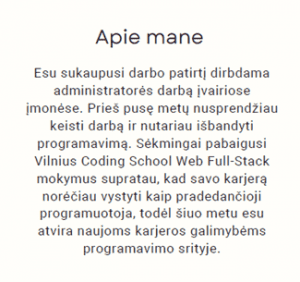
It is very important that a potential employer can contact you, so the contact information should be in a visible place - at the top of the CV or on the side, depending on the CV template. In this block, you should indicate the place of residence (the name of the city is enough), phone number, e-mail address. email address, link to LinkedIn account and link to projects created during your training. In our time, a significant part of communication regarding job searches takes place through the LinkedIn platform, so an employer can contact you through this social network. A reference to your projects is necessary so that the employer can assess your level of technology knowledge (CVs containing references to work samples are significantly more informative and help employers make positive decisions about invitations to job interviews). We recommend creating an e-mail address. e-mail address with your first and last name, as witty or humorous nicknames can create an impression of unprofessionalism. The same rule applies to your social networks (especially LinkedIn). We would recommend naming this section "Personal Information".
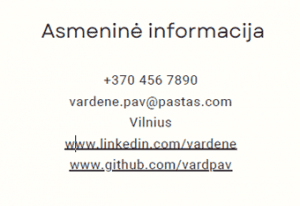
It is not necessary to indicate age, gender, marital status, number of children or nationality with the information about yourself. These items do not provide any valuable information about you as an employee and should not influence your employment decision.
Typically, a person who changes professions does not have work experience related to the field in which they are retraining, so it is not uncommon for previous work experiences to have less valuable information than completed training that is directly related to the IT field. For example, if you are applying for the position of an entry-level Java programmer, your completed/attended training (e.g. Java programming basics training) will be more valuable information than 5 years of sales experience. Therefore, if you have completed IT training and your work experience is not related to the position you are applying for, the next part after "Personal information" should be "Training" or "Education". Training should be arranged in reverse order from newest to oldest. We recommend that you describe the training in detail, indicating the duration of the training in hours and weeks or months. Also indicate the knowledge acquired during the training, the topics covered. If you completed assignments or created a final project during training, be sure to include a link to your work. This part is extremely important, because from it the employer will get a lot of useful information about you as a specialist.
Also, in this section, indicate information about your acquired education (higher, secondary or other).
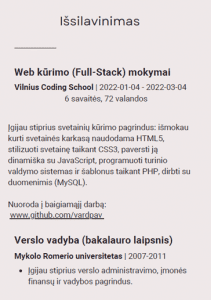
Information about your education should be followed by your work experience. Write work experience in reverse order, i.e. Y. From the latest or current place of employment, indicating previous work experience. If you have many years of experience in various workplaces, you can indicate only the last 3 or those where you worked for the last 5 years. If your work experience is not related to the field in which you are retraining, it is enough to describe each job position in 1-2 sentences. You can specify the rest of your work experience in the "from-to" period, for example "2010-2015". work in various managerial positions". In this case, no description is needed.
If you have no real work experience, you can list organizations where you have volunteered or done internships. If you do not have any work/internship/volunteering experience, you can skip this section.
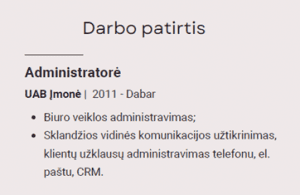
Also, be sure to mention your technical skills in your CV that are relevant to the field you are retraining for or the position you are applying for. Avoid evaluating technical skills in levels (eg HTML5 - Basic), percentages (eg SQL - 75%) and other expressions that do not specifically define what you can do. It would be correct to specify the skills as follows: for example, HTML5 - to create the structure of the website; Power BI - create reports; Create test scripts etc. Such a presentation of skills very clearly defines your competences and makes your CV more informative.
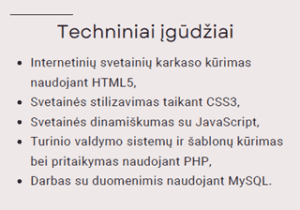
Other important information in your resume is your native language and knowledge of foreign languages. The languages you speak should be listed in terms of words or international levels (eg A2, B1, C1). We recommend specifying international levels only if you have a certificate confirming this.
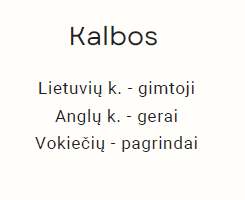
Finally, you can include personal qualities and hobbies in your CV. When describing the part of personal characteristics, we recommend that you name only those characteristics that are unique to you, for example, you are very communicative and friendly or very thorough, etc. Avoid listing all the qualities you know that are not your strengths - it is not the quantity of qualities that matters, but quality information that reflects your strengths.
If you would like to work in an international company and you know English, you should prepare your CV in English. In the event that your level of knowledge of English is low or you do not speak this language, your CV should be prepared in Lithuanian. We would like to draw your attention to one unwritten rule - if the job advertisement is in English, the CV should be prepared in this language, if the advertisement is in Lithuanian, the CV should also be prepared in Lithuanian.
After you have completed your resume, review it for any grammatical, typographical, or spelling errors. If you don't feel literate enough or you write in English and you lack knowledge, ask more knowledgeable people to review your CV. A resume with many mistakes can be rejected immediately without even evaluating the content.
We've covered the essentials that a good resume should include. Of course, you should adapt it according to your experience, aspirations and characteristics. Everything that you think is important should appear in the CV, but stick to the golden mean - better less, but true and to the point, than an overloaded resume. Keep in mind that potential employers or employees reading CVs spend around 5-20 seconds per CV. During this time, your CV must catch the eye and hook you.



